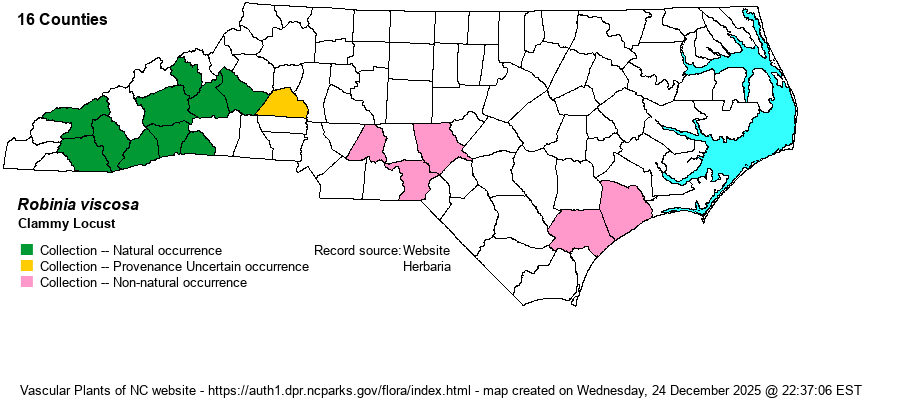| Author | Ventenat | |
| Distribution | The fact this this species easily escapes or is so often planted makes delineation of the native range very uncertain. Certainly native to the southern Mountains and nearby southern Piedmont foothills, apparently east to Burke County. Ranges north to Yancey and Burke counties. A few records from the southern Coastal Plain certainly represent escapes or plantings. Note that some of the counties in green on the map (natural occurrence) could well be coded in orange (provenance uncertain). Reports from Mitchell and Haywood counties at USDA website are not supported by specimens at SERNEC.
This is a narrow southern Appalachian endemic, occurring north to WV and western VA, and south to northern GA and northeastern AL.
| |
| Abundance | Apparently infrequent or uncommon when all occurrences within its Mountain and western Piedmont range are considered. This is a State Significantly Rare species. The range map does not correlate well with the NCNHP's State Rank of S1, and some montane populations may not be truly natural. However, truly native populations do seem quite rare, at least now. A rank of S1? or S1S2 could easily be applied as well. | |
| Habitat | It was originally restricted to open woods and wooded slopes, presumably mostly in dry to mesic soils of the upper portions of mountains and ridges. However, it now is often reported on roadbanks, roadsides, and clearings. | |
| Phenology | Blooms in May and June, and fruits from July to September. | |
| Identification | This is a large shrub to small deciduous tree, often to 10-15 feet tall, rarely taller. It has 11-25 leaflets and thus is quite similar to other locusts in overall appearance, though it has pink to pale pink flowers. The very similar R. hartwigii, often considered as a variety of R. viscosa, is quite similar but usually is shorter in stature, often has richer pink to rose colored flowers, and is typically not quite as sticky or “clammy” on the twigs and inflorescence. See technical keys for identification. Generally speaking, a tall shrub or small tree locust species, with quite sticky twigs, will be this species if found along a roadbank, forest clearing, or other disturbed area not on the top of a granitic dome. | |
| Taxonomic Comments | Though this species does not have issues at the full species level, other taxa are frequently assigned to it, especially the Hartwig’s Locust, which is considered a valid species here but is named as R. viscosa var. hartwigii [or var. hartwegii] by the “lumpers”.
| |
| Other Common Name(s) | None | |
| State Rank | S1 [S1S2] | |
| Global Rank | G3 | |
| State Status | SR-T | |
| US Status | | |
| USACE-agcp | | |
| USACE-emp | | |

